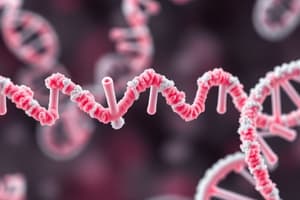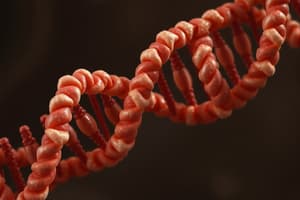Podcast
Questions and Answers
Fluoroquinolones inhibit bacterial replication by directly interfering with the function of which of the following enzymes?
Fluoroquinolones inhibit bacterial replication by directly interfering with the function of which of the following enzymes?
- Reverse transcriptase
- Bacterial RNA polymerase
- DNA gyrase and topoisomerase IV (correct)
- Ribosomal peptidyl transferase
Which of the following resistance mechanisms is NOT typically associated with fluoroquinolone resistance in bacteria?
Which of the following resistance mechanisms is NOT typically associated with fluoroquinolone resistance in bacteria?
- Decreased expression of efflux pumps (correct)
- Reduced membrane permeability to the drug
- Enzymatic degradation of the fluoroquinolone
- Mutation in genes encoding DNA gyrase
A patient is prescribed ciprofloxacin for a urinary tract infection. Which instruction should the healthcare provider emphasize regarding concomitant medication use?
A patient is prescribed ciprofloxacin for a urinary tract infection. Which instruction should the healthcare provider emphasize regarding concomitant medication use?
- Oral absorption is enhanced by calcium supplements
- It can be taken with any medications or supplements with no effect
- Ciprofloxacin absorption is significantly increased when taken with antacids
- Ciprofloxacin should be taken 2 hours before or 6 hours after consuming antacids (correct)
Which of the following statements best describes the spectrum of activity of first-generation fluoroquinolones such as nalidixic acid?
Which of the following statements best describes the spectrum of activity of first-generation fluoroquinolones such as nalidixic acid?
A patient with a severe kidney impairment requires treatment with a fluoroquinolone. Which pharmacokinetic consideration is most important?
A patient with a severe kidney impairment requires treatment with a fluoroquinolone. Which pharmacokinetic consideration is most important?
How does the mechanism of action of fluoroquinolones lead to bacterial cell death?
How does the mechanism of action of fluoroquinolones lead to bacterial cell death?
What is the primary difference in the spectrum of activity between ciprofloxacin and moxifloxacin?
What is the primary difference in the spectrum of activity between ciprofloxacin and moxifloxacin?
Mutations in bacterial genes encoding DNA gyrase or topoisomerase IV, leading to altered target site structure, directly cause what form of resistance?
Mutations in bacterial genes encoding DNA gyrase or topoisomerase IV, leading to altered target site structure, directly cause what form of resistance?
Flashcards
Fluoroquinolones: Mechanism
Fluoroquinolones: Mechanism
Inhibit bacterial DNA synthesis by binding to type II topoisomerases (DNA gyrase and topoisomerase IV), causing chromosomal breaks and cell lysis.
Fluoroquinolones: Primary targets
Fluoroquinolones: Primary targets
DNA gyrase (Gram-negative bacteria) and topoisomerase IV (Gram-positive bacteria).
Fluoroquinolone Generations
Fluoroquinolone Generations
1st: Nalidixic acid (Moderate G-ve), 2nd: Ciprofloxacin (Expanded G-ve, Mild G+ve), 3rd: Levofloxacin (Expanded G-ve, Moderate G+ve), 4th: Moxifloxacin, Gemifloxacin, Delafloxacin (Expanded G-ve, Improved G+ve)
Fluoroquinolone Resistance
Fluoroquinolone Resistance
Signup and view all the flashcards
Altered Target Binding
Altered Target Binding
Signup and view all the flashcards
Decreased Drug Accumulation
Decreased Drug Accumulation
Signup and view all the flashcards
Fluoroquinolones: Absorption
Fluoroquinolones: Absorption
Signup and view all the flashcards
Fluoroquinolones: Distribution
Fluoroquinolones: Distribution
Signup and view all the flashcards
Study Notes
- Antimicrobials include quinolones, folic acid antagonists, and urinary tract antiseptics.
Fluoroquinolones
- Bacterial species have two distinct type II topoisomerases.
- DNA gyrase breaks the double-strand DNA and introduces negative supercoils.
- Topoisomerase IV separates daughter chromosomes once replication is completed.
- Fluoroquinolones bind to these enzymes and interfere with DNA ligation, causing chromosomal breaks and cell lysis.
- The main target for gram-negative bacteria is DNA gyrase, while for gram-positive bacteria, it is topoisomerase IV.
- Spectrum*
- First generation: Nalidixic acid (Moderate G-ve)
- Second generation: Ciprofloxacin (Expanded G-ve, mild G+ve)
- Third generation: Levofloxacin (Expanded G-ve, Moderate G+ve)
- Fourth generation: Moxifloxacin, Gemifloxacin, Delafloxacin (Expanded G-ve, improved G+ve)
- Resistance Mechanisms*
- Altered target binding happens due to mutations in bacterial genes encoding DNA gyrase or topoisomerase.
- The mutations alter the target site structure and reduce the binding efficiency of fluoroquinolones.
- Decreased accumulation occur via reduced membrane permeability or efflux pumps.
- Fluoroquinolone degradation can happen via acetylation to become inactive.
- Pharmacokinetics*
- Fluoroquinolones are bioavailable orally.
- Absorption is reduced if co-ingested with sucralfate, aluminum, magnesium-containing antacids, zinc or iron supplements, and calcium preparations.
- Fluoroquinolones distribute well to tissues, body fluids, bone, urine, and CSF.
- Fluoroquinolones are mostly excreted renally, requiring dose adjustments in renal impairment.
- Adverse Reactions*
- Can induce tendinitis
- Can cause Diarrhea, Nausea, Headache and Dissiness
- Can prolong the QT interval
- Can cause arrhythmia, seizures peripheral neuropathy and phototoxicity
Folate Antagonists
- Humans use dietary folate to synthesize tetrahydrofolic acid.
- Many bacteria cannot absorb folate derivatives and must synthesize folate de novo.
- Sulfonamides* (Mafenide – Sulfadiazine – Sulfasalazine)
- Sulfonamides are synthetic analogs of PABA and compete with it to inhibit dihydropteroate synthetase.
- The inhibition of dihydropteroate synthetase reduced the genesis of bacterial dihydrofolic acid, leading to a bacteriostatic effect.
- Sulfonamides exhibit some activity against both Gram-positive and negative bacteria.
- Resistance Mechanisms*
- Altered target via modification of dihydropteroate synthase occurs.
- Decreased permeability
- Pharmacokinetics*
- Most sulfonamides are well absorbed orally, except for sulfasalazine.
- Intravenous sulfonamides are used only in emergencies due to the risk of sensitization.
- Mafenide and silver sulfadiazine can be applied topically to reduce burn-associated sepsis.
- Sulfonamides are albumin-bound and can penetrate into the CSF and placenta.
- Sulfonamides are metabolized in the liver via acetylation into toxic metabolites
- These toxic metabolites may cause crystalluria and kidney damage.
- Sulfonamides are mainly excreted renally and, to some extent, in breast milk.
- Adverse Effects*
- Adequate hydration and alkalinization promotes ionization and reduces crystalluria.
- Hypersensitivity reactions include rash, angioedema, and Stevens-Johnson syndrome.
- Hemapoietic effects include hemolytic anemia in patients with G6PD deficiency.
- Kernicterus is bilirubin-associated brain damage in newborns as sulfonamides displace bilirubin from albumin binding that goes past the BBB (not well developed in newborns).
- Contraindications*
- Avoided in newborns and infants under 2 months and in pregnant women at term.
- Sulfonamides should not be given with methenamine due to potential crystallization with formaldehyde.
Trimethoprim
- Mechanism of Action*
- A potent inhibitor of bacterial dihydrofolate reductase inhibits active folic acid formation.
- It has greater affinity to bacterial than human dihydrofolate reductase, which accounts for its toxicity
- Spectrum*
- Similar spectrum to sulfamethoxazole with 20-50 fold greater potency.
- May be used alone for urinary tract infections (UTIs).
- Resistance mechanisms*
- Altered dihydrofolate reductase
- Efflux pumps & reduced permeability
- Pharmacokinetics*
- Exhibit good oral bioavailability.
- Higher concentrations are achieved in acidic prostatic and vaginal fluids due to being a weak base.
- Penetrates into the CSF
- Mostly renally excreted unchanged.
- Adverse Effects*
- Causes Folic acid deficiency symptoms (megaloblastic anemia, leukopenia, granulocytopenia).
- Symptoms are worse in pregnant patients and those with nutrient-poor diets.
- Blood disorders can be reversed by folinic acid (leucovorin), which does not enter bacteria.
- Acts as a potassium can cause hyperkalemia
Cotrimoxazole (trimethoprim + sulfamethoxazole)
- Mechanism of Action*
- Combined antimicrobial activity results from inhibition of two steps of tetrahydrofolic acid synthesis.
- Sulfamethoxazole inhibits PABA incorporation.
- Trimethoprim inhibits dihydrofolate reduction to tetrahydrofolate.
- Resistance*
- Less resistance due to combination.
- Pharmacokinetics*
- Is administered orally, but I.V. in certain conditions.
- Both agents are distributed throughout the body.
- Trimethoprim concentrates in acidic prostatic fluids.
- This helps cotrimoxazole to treat of prostatitis.
- Cotrimoxazole can readily crosses the BBB.
- Both parent drugs and their metabolites are excreted in the urine
Urinary Tract Antiseptics
- Methenamine*
- Mechanism of Action*
- Methenamine salts are hydrolyzed to ammonia + formaldehyde in acidic urine (pH ≤ 5.5).
- Formaldehyde denatures proteins and nucleic acids, which leads to bacteria cell death.
- Formulated with weak acid (e.g., hippuric acid) to maintain urine acidity and promote formaldehyde production.
- Spectrum*
- Used for chronic suppressive therapy to reduce the frequency of UTIs.
- Main benefit is its lack of resistance.
- Pharmacokinetics*
- Active orally with up to 30% decomposing in gastric juices, unless enteric coated.
- Renally excreted.
- Use should be avoided in hepatic insufficiency due to ammonia formation.
- Adverse Effects*
- GIT distress occur
- Higher doses may cause albuminuria, hematuria, and rashes.
- Methenamine mandelate is contraindicated in patients with renal insufficiency due to mandelic acid precipitation.
- The methenamine hippurate formulation is preferable.
- Sulfonamides react with formaldehyde; do not use concomitantly with methenamine because of the increased risk of crystalluria and mutual antagonism.
Nitrofurantoin
- First introduced in the 1960s for cystitis.
- It was rarely used until recently, when it was resurrected due to increased bacterial resistance.
- Mechanism of Action*
- Inhibits DNA and RNA synthesis.
- Pharmacokinetics*
- Bioavailable orally with 40% renal excretion
- Adverse Effects*
- Can cause Nausea, vomiting and diarrhea.
- This can be reduced with use of microcrystalline preparation
- Can cause pulmonary fibrosis and neuropathy (rare - exposure>1 month)
Studying That Suits You
Use AI to generate personalized quizzes and flashcards to suit your learning preferences.




